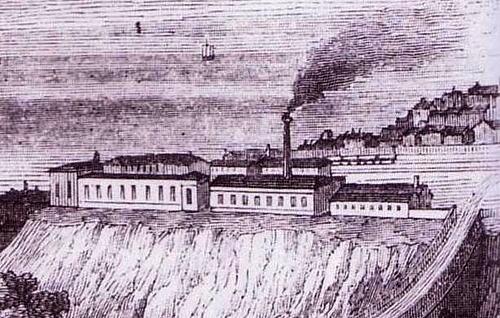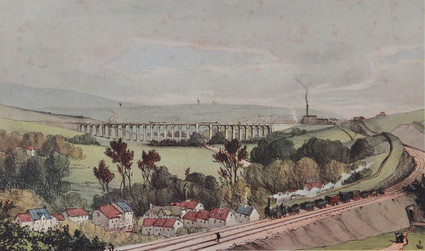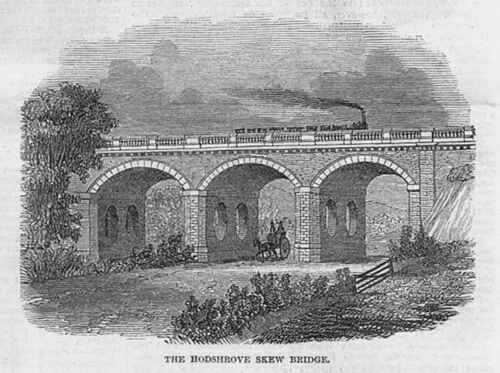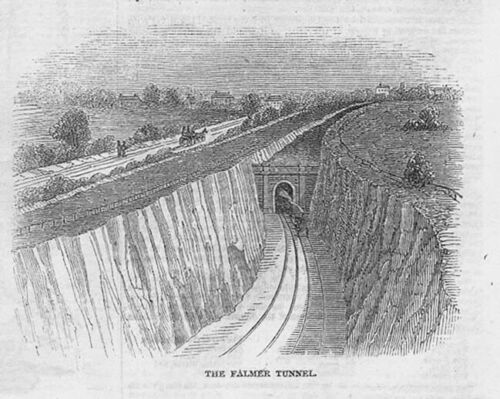

PHOTOGRAPHER UNKNOWN
The view of Brighton station and locomotive works in the foreground c1846
CHICHESTER 1846-c1870
Chichester loco shed was a two road dead end shed on the Down Side, and was opened by the L.B.S.C.R. with the line from Lyminster on 8th June 1846. Chichester at that time was the Railhead until the line was extended to Havant on 15th March 1847 and to Portsmouth on 14th June 1847. Allocation of locomotives is unknown, but probably a couple of locos for services between Portsmouth and Lyminster.
The date the shed is unknown, but it is believed to be early 1870s, during Stroudley’s ‘House Cleaning’. The shed disappeared in the works that were associated with re-signalling and track re-organisation at Chichester in 1875.
According to the Illustrated London News of the 6th June 1846, stated that the excursion to Brighton ‘on Monday last’ (Monday 1st June) consisted of forty four carriages carrying 4,000 passengers.
PHOTOGRAPHER UNKNOWN
Brighton, Lewes and Hastings Railway line opened on 8th June,1846 and a single between
Lewes to Bulverhythe (St. Leonards) on the 27th June 1846 and was double in January1849.
London & Croydon Railway on the 27th July 1846
merged with other railways to form
the London Brighton & South Coast Railway
PHOTOGRAPHER UNKNOWN
London Road Viaduct as seen in the mid 1840s
The London & Brighton Railway merged under an act of Parliament of 27th July 1846, with the Brighton & Chichester Railway and the Brighton, Lewes & Hastings Railway to become the London Brighton & South Coast Railway. Over the coming years many other lines where built in and around the Sussex and Surrey area, with some lines being started but never being completed.
The main line to London and the branches to Shoreham and Lewes were constructed by the London and Brighton Railway Company. Mainly owing to financial considerations, the London, Brighton and South Coast Railway Company was formed under an Act of Parliament of July 1846 by amalgamating the London and Brighton; London and Croydon; Croydon and Epsom; Brighton, Lewes and Hastings; and the Brighton and Chichester railway companies. The London, Brighton and South Coast had 457 miles of track, covering most of Sussex and much of south London and Surrey.
EPSOM LOCO SHED
1846 -1925
The London & Croydon Railway opened a motive power depot in 1846

PHOTOGRAPHER UNKNOWN
The inside of Epsom Town Loco Shed sometime later

PHOTOGRAPHER UNKNOWN
On the 27th July 1846 the London & Croydon Railway and the London & Brighton Railway
merged along with other smaller railways to form the London Brighton & South Coast
Railway.

LONDON & CROYDON RAILWAY
Regulations for the First Appointment of an Engineman.
1 The candidate must not be under twenty-one years of age, and must produce a certificate of a sound constitution and steady habits.
2 He must be able to read and write, and if possible, understand the rudimental principles of mechanics.
3 It will be a great recommendation if he has served his time to any mechanical art, especially as a Fitter of Locomotive Engines; and, if possible, he should produce testimonials stating his qualifications as such.
4 If the candidate has been a Fitter or a stationary Engine-man, he must, for several months at least, have been a Stoker on a Locomotive Engine, under the direction of a steady and competent Engine-man; and before his appointment, he should produce a testimonial from the Superintendent of Locomotives, or at least from an Engine-man under whom he has served, stating full confidence in his acquaintance with the construction of an Engine and the principles of its management.
5 If the candidate has not been a Fitter or a stationary Engine-man, he must have served as a Stoker for at least two years, and produce the testimonials named in the preceding rules.
6 If require by the Board of Directors, for greater security, the candidate must undergo an examination from their Engineer, Superintendent of Locomotive, or other competent person, as to his knowledge of an Engine and its management, and the general result of this examination must be committed to paper, signed by the examiner, and presented to the board.
7 The Engineer or Superintendent of Locomotives of the Railway to which the candidate is desirous of being appointed, shall sign a certificate stating that he has conversed with him, has seen him drive and has confidence in his steadiness and ability.
8 Before being allowed to take the entire charge of an Engine and train, the candidate must drive for several days under the direction of an experienced Engine-man, who must be on his Engine, and certify to ability.
9 All certificates and testimonials must be deposited with the Secretary of the Company, who will restore them to the owner on his leaving their service.
Framed by the then Mr C. H. Gregory, in his capacity as the Company’s Resident Engineer, and adopted by the Directors of the L&C Rly in 1840.
The London & Croydon Rly &
the London & Brighton Rly
amalgamated on the
27th July 1846
